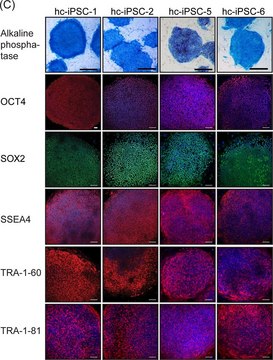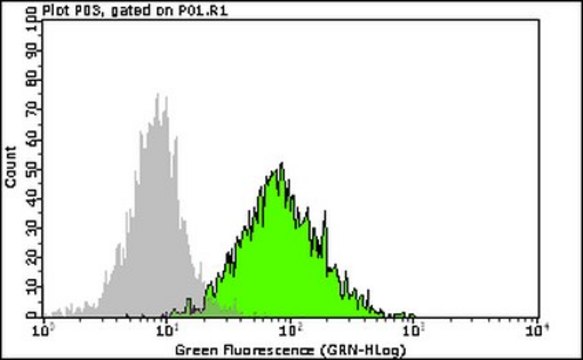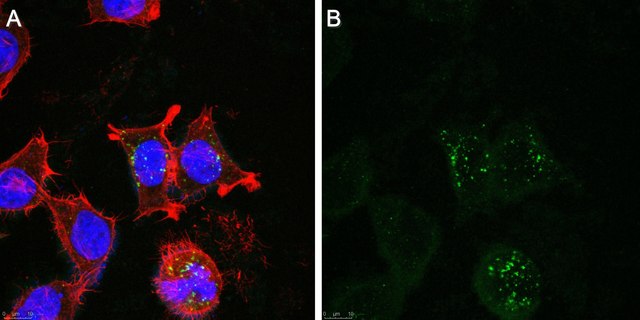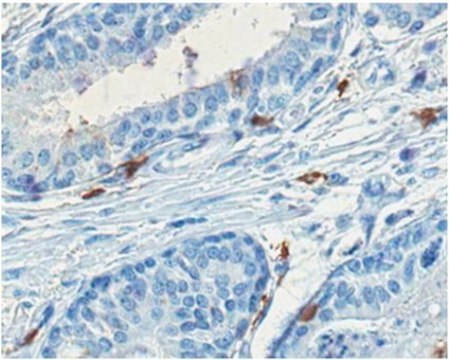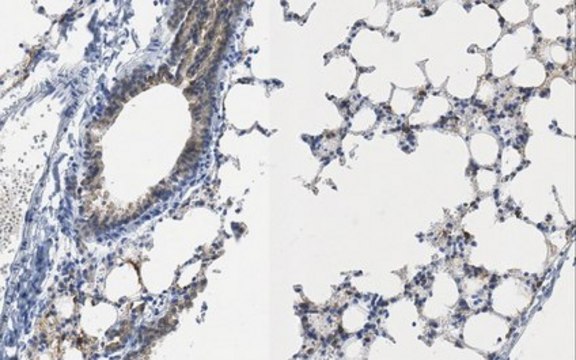推荐产品
生物来源
rat
质量水平
抗体形式
purified antibody
抗体产品类型
primary antibodies
克隆
MC-631, monoclonal
种属反应性
human
种属反应性(根据同源性预测)
mouse
技术
flow cytometry: suitable
immunocytochemistry: suitable
immunofluorescence: suitable
immunohistochemistry: suitable
同位素/亚型
IgMκ
运输
wet ice
靶向翻译后修饰
unmodified
一般描述
阶段特异性胚胎抗原3(SSEA-3)是由与鞘脂连接的五个碳水化合物单元组成的糖鞘脂。鞘脂是细胞信号传导的关键参与者,SSEA-3是干细胞(ESC、MSC、iPSC、CSC)分化的众所周知的标志物,当细胞开始分化时,SSEA-3迅速消失。
特异性
与在人畸胎瘤干细胞(EC)、人胚胎生殖细胞(EG)和人胚胎干细胞(ES)表面表达的阶段特异性胚胎抗原-3(SSEA-3)反应。未分化的鼠EC、ES和EG细胞没有明显的免疫反应性。人EC细胞分化后,SSEA-3的表达下调。相反,鼠EC和ES细胞的分化可能伴随着SSEA-3表达的增加。
免疫原
4-8细胞期小鼠胚胎。
应用
免疫细胞化学分析:10µg/mL代表性批次在H9细胞中检测到阶段特异性胚胎抗原-3。
免疫细胞化学分析:一个代表性批次通过荧光免疫细胞化学在T
细胞来源的iPSC(TiPSC)中检测到SSEA-3免疫反应性(Kishino,Y.,et al.(2014).PLoS One.9(5):e97397)。
免疫细胞化学分析:一个代表性批次通过荧光免疫细胞化学在培养的HCT116结肠直肠癌(CRC)细胞中检测到SSEA-3阳性癌症干细胞(CSC)的存在(Suzuki,Y.,et al.(2013).Int. J. Oncol.42(1):161-167)。
免疫细胞化学分析:一个代表性批次通过荧光免疫细胞化学检测到来自人臼齿来源的间充质基质细胞(MSC)的诱导多能干(iPS)细胞中的SSEA-3免疫反应性(Oda,Y.,et al.(2010).J. Biol. Chem. 285(38):29270-29278)。
流式细胞术分析: 一个代表性批次在五种培养的结直肠癌(CRC)细胞系HCT116、Caco-2、DLD-1、HT-29和SW480中检测到SSEA-3阳性癌症干细胞(CSC)的存在(Suzuki,Y.,et al.(2013).Int. J. Oncol.42(1):161-167)。
免疫荧光分析:一个代表性批次通过使用冷冻组织切片的荧光免疫组织化学检测到正常结肠直肠上皮细胞中大量的SSEA-3阳性基质细胞和结肠直肠腺癌中的SSEA-3阳性癌症(Suzuki,Y.,et al.(2013).Int. J. Oncol.42(1):161-167)。
免疫细胞化学分析:一个代表性批次通过荧光免疫细胞化学在T
细胞来源的iPSC(TiPSC)中检测到SSEA-3免疫反应性(Kishino,Y.,et al.(2014).PLoS One.9(5):e97397)。
免疫细胞化学分析:一个代表性批次通过荧光免疫细胞化学在培养的HCT116结肠直肠癌(CRC)细胞中检测到SSEA-3阳性癌症干细胞(CSC)的存在(Suzuki,Y.,et al.(2013).Int. J. Oncol.42(1):161-167)。
免疫细胞化学分析:一个代表性批次通过荧光免疫细胞化学检测到来自人臼齿来源的间充质基质细胞(MSC)的诱导多能干(iPS)细胞中的SSEA-3免疫反应性(Oda,Y.,et al.(2010).J. Biol. Chem. 285(38):29270-29278)。
流式细胞术分析: 一个代表性批次在五种培养的结直肠癌(CRC)细胞系HCT116、Caco-2、DLD-1、HT-29和SW480中检测到SSEA-3阳性癌症干细胞(CSC)的存在(Suzuki,Y.,et al.(2013).Int. J. Oncol.42(1):161-167)。
免疫荧光分析:一个代表性批次通过使用冷冻组织切片的荧光免疫组织化学检测到正常结肠直肠上皮细胞中大量的SSEA-3阳性基质细胞和结肠直肠腺癌中的SSEA-3阳性癌症(Suzuki,Y.,et al.(2013).Int. J. Oncol.42(1):161-167)。
研究子类别
细胞周期、DNA复制&修复
细胞周期、DNA复制&修复
研究类别
干细胞研究
干细胞研究
该抗阶段特异性胚胎抗原-3抗体(克隆MC-631)经验证可用于流式细胞术、免疫细胞化学、免疫荧光和免疫组织化学检测阶段特异性胚胎抗原-3。
质量
通过流式细胞术在H9细胞中进行评估。
流式细胞术分析: 1.0 µg该抗体在H9细胞中检测到阶段特异性胚胎抗原-3。
流式细胞术分析: 1.0 µg该抗体在H9细胞中检测到阶段特异性胚胎抗原-3。
联系
替代:MAB4303
外形
形式:纯化
纯化的大鼠单克隆IgMκ抗体,溶于含0.05%叠氮化钠的PBS中。
储存及稳定性
自接收之日起,在2-8°C下可稳定保存1年。
其他说明
浓度:请参考特定批次的数据表。
免责声明
除非我们的目录或产品随附的其他公司文件中另有说明,否则我们的产品预期仅用于研究用途,不得用于任何其他目的,包括但不限于未经授权的商业用途、体外诊断用途、离体或体内治疗用途或对人类或动物的任何类型的消费或应用。
未找到合适的产品?
试试我们的产品选型工具.
储存分类代码
10 - Combustible liquids
WGK
WGK 2
闪点(°F)
Not applicable
闪点(°C)
Not applicable
Yozo Suzuki et al.
International journal of oncology, 42(1), 161-167 (2012-11-24)
Findings from studies on stem cells have been applied to cancer stem cell (CSC) research, but little is known about the relationship between ES cell-related cell surface markers and CSCs. In this study, we focused on stage-specific embryonic antigen 3
Honorine Dushime et al.
Stem cell research & therapy, 14(1), 201-201 (2023-08-12)
Human multilineage-differentiating stress enduring (Muse) cells are nontumorigenic endogenous pluripotent-like stem cells that can be easily obtained from various adult or fetal tissues. Regenerative effects of Muse cells have been shown in some disease models. Muse cells specifically home in
Yasuaki Oda et al.
The Journal of biological chemistry, 285(38), 29270-29278 (2010-07-03)
The expression of four transcription factors (OCT3/4, SOX2, KLF4, and MYC) can reprogram mouse as well as human somatic cells to induced pluripotent stem (iPS) cells. We generated iPS cells from mesenchymal stromal cells (MSCs) derived from human third molars
Yoshikazu Kishino et al.
PloS one, 9(5), e97397-e97397 (2014-05-16)
Recently, induced pluripotent stem cells (iPSCs) were established as promising cell sources for revolutionary regenerative therapies. The initial culture system used for iPSC generation needed fetal calf serum in the culture medium and mouse embryonic fibroblast as a feeder layer
Ida Annunziata et al.
Nature communications, 10(1), 3623-3623 (2019-08-11)
Coordinated regulation of the lysosomal and autophagic systems ensures basal catabolism and normal cell physiology, and failure of either system causes disease. Here we describe an epigenetic rheostat orchestrated by c-MYC and histone deacetylases that inhibits lysosomal and autophagic biogenesis
我们的科学家团队拥有各种研究领域经验,包括生命科学、材料科学、化学合成、色谱、分析及许多其他领域.
联系技术服务部门